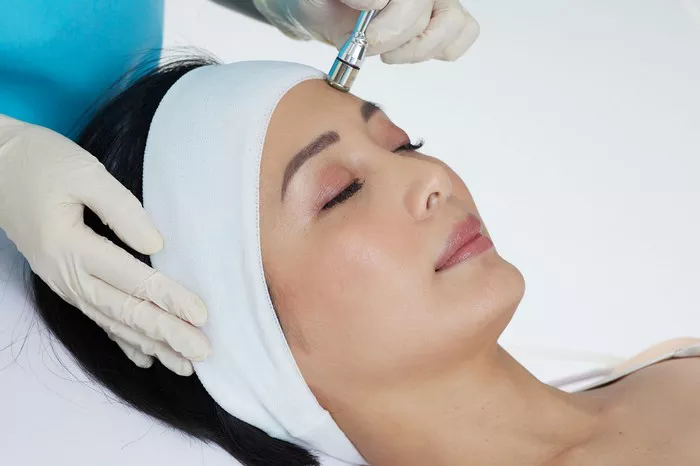Microdermabrasion is a popular non-invasive cosmetic procedure that aims to improve the texture and appearance of the skin. It involves the exfoliation of the outermost layer of the skin using tiny abrasive crystals or a diamond-tipped wand. While microdermabrasion is generally considered safe and effective, there are concerns and misconceptions about its potential to damage the skin. In this article, we will explore the facts surrounding microdermabrasion and address the question: Can microdermabrasion damage your skin?
Understanding Microdermabrasion
Microdermabrasion is a mechanical exfoliation technique that targets the outermost layer of the skin, known as the stratum corneum. The procedure works by using either fine crystals or a diamond-tipped wand to gently abrade the skin surface, removing dead skin cells and stimulating collagen production. This exfoliation process helps to improve skin texture, reduce fine lines, diminish hyperpigmentation, and promote a more youthful and radiant complexion.
The Safety of Microdermabrasion
When performed by a trained professional, microdermabrasion is generally safe for most individuals and skin types. The procedure is non-invasive, does not require anesthesia, and typically does not have a lengthy recovery period. It is important to note that microdermabrasion is considered a superficial treatment and does not penetrate deeply into the skin layers.
Potential Side Effects of Microdermabrasion
While microdermabrasion is generally safe, there are potential side effects that can occur, especially if the procedure is not performed correctly or if the patient has pre-existing skin conditions. These side effects may include:
- Redness and Sensitivity: Following microdermabrasion, it is common for the skin to appear slightly red and feel sensitive or tender. This is a temporary side effect that usually subsides within a few hours to a day.
- Dryness and Flaking: Microdermabrasion can temporarily strip away the outer layer of the skin, which may result in dryness and flaking. It is important to keep the skin moisturized and protected with a gentle, hydrating moisturizer after the procedure.
- Bruising and Swelling: In some cases, microdermabrasion can cause mild bruising or swelling, especially if the skin is overly sensitive or the procedure is performed too aggressively. These side effects are usually temporary and subside within a few days.
- Increased Sensitivity to Sunlight: Microdermabrasion can make the skin more sensitive to sunlight. It is essential to apply sunscreen with a high SPF and avoid direct sun exposure immediately after the procedure.
- Skin Irritation or Allergic Reactions: Although rare, some individuals may experience skin irritation or allergic reactions to the crystals or products used during the procedure. It is crucial to inform your skincare professional about any known allergies or sensitivities before undergoing microdermabrasion.
Risk Factors and Precautions
While microdermabrasion is generally safe, certain risk factors and precautions should be considered:
- Skin Conditions: Individuals with certain skin conditions, such as active acne, rosacea, eczema, or psoriasis, may be advised to avoid or postpone microdermabrasion. These conditions can make the skin more susceptible to irritation, inflammation, or infection.
- Skin Sensitivity: People with naturally sensitive skin may be more prone to experiencing side effects from microdermabrasion. It is important to communicate your skin type and sensitivity level to your skincare professional to ensure that the procedure is customized to your specific needs.
- Pregnancy and Breastfeeding: Microdermabrasion is generally not recommended for pregnant or breastfeeding individuals due to the lack of research on its safety during these periods.
Choosing a Qualified Professional
To minimize the risk of complications and ensure the best possible outcome, it is crucial to choose a qualified professional to perform microdermabrasion. Consider the following tips:
- Research and Credentials: Look for skincare professionals who are trained, licensed, and experienced in performing microdermabrasion. Research their credentials, read reviews, and ask for before-and-after photos of previous clients.
- Consultation: Schedule a consultation before the procedure to discuss your skin concerns, goals, and any medical history or skin conditions you may have. A qualified professional will assess your skin type and determine if microdermabrasion is suitable for you.
- Customized Treatment: Each individual’s skin is unique, and a reputable professional will tailor the treatment to your specific needs. They will adjust the intensity of the procedure and the type of abrasive material used based on your skin type, sensitivity, and desired outcomes.
- Aftercare Recommendations: A knowledgeable professional will provide you with aftercare instructions and recommendations on skincare products to use post-treatment. They will guide you on how to protect and nourish your skin to optimize the results and minimize potential side effects.
Conclusion
When performed by a qualified professional, microdermabrasion is generally safe and effective for improving the texture and appearance of the skin. While there are potential side effects, such as temporary redness, dryness, and sensitivity, the risk of significant damage to the skin is minimal. It is essential to communicate openly with your skincare professional, disclose any skin conditions or sensitivities, and follow their aftercare instructions diligently. By doing so, you can enjoy the benefits of microdermabrasion and achieve smoother, healthier-looking skin.


